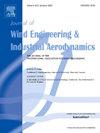Performance-based wind design of tall mass timber buildings with coupled post-tensioned cross-laminated timber shear walls
IF 4.9
2区 工程技术
Q1 ENGINEERING, CIVIL
Journal of Wind Engineering and Industrial Aerodynamics
Pub Date : 2025-02-01
DOI:10.1016/j.jweia.2024.105981
引用次数: 0
Abstract
Engineered timber panels, such as cross-laminated timber (CLT), have enabled tall mass timber buildings to reach heights equivalent to mid-rise concrete and steel buildings. Tall mass timber buildings are lighter and more flexible than their concrete and steel equivalents, which makes their design wind-critical. The current prescriptive code-based design of main wind force resisting systems (MWFRSs) only considers buildings’ linear-elastic capacity, resulting in costly designs requiring commercially unavailable timber cross sections. This prevents engineers from fully utilizing timber as MWFRS and limits the height that mass timber buildings can reach. In performance-based wind design (PBWD), nonlinear-inelastic deformation in specially designed and detailed parts of MWFRSs enables an optimal design. However, controlling damage accumulation in structures can be challenging due to the substantial mean component of wind loads in the along-wind direction. To this end, self-centering systems such as coupled post-tensioned CLT (PT-CLT) walls can offer a solution. However, despite extensive analytical and experimental studies on the use of PT-CLT walls as seismic force-resisting systems, their use as MWFRSs has not been explored. Therefore, this paper proposes the use of PT-CLT walls as MWFRSs in tall mass timber buildings and develops a new PBWD approach for their design. To demonstrate the applicability of the PBWD approach, 8- and 16-story prototype mass timber buildings hypothetically located in Toronto, Canada, were designed using PBWD and load information from wind tunnel tests. For performance assessment, three-dimensional multi-spring numerical models were developed in OpenSeesPy and validated with full-scale quasi-static cyclic and shaking table experimental tests. Performance assessments using nonlinear response history analysis (NLRHA) under simultaneous along-, across-, and torsional-wind loads for 36 wind directions were carried out. The results indicate that the proposed PBWD framework is practical and effective for designing PT-CLT shear walls as MWFRSs in tall mass timber buildings.
后张交叉叠板剪力墙高层大质量木结构建筑的性能风设计
工程木板,如交叉层压木材(CLT),使高大的大型木结构建筑达到相当于中层混凝土和钢结构建筑的高度。高大的木结构建筑比混凝土和钢结构建筑更轻,更灵活,这使得它们的设计对风力至关重要。目前基于规范的主要抗风系统(mwfrs)设计只考虑建筑物的线弹性能力,导致设计成本高昂,需要商业上无法获得的木材截面。这使工程师无法充分利用木材作为MWFRS,并限制了大量木结构建筑的高度。在基于性能的风设计(PBWD)中,mwfrs特殊设计和详细部件的非线性非弹性变形可以实现优化设计。然而,控制结构的损伤积累可能具有挑战性,因为沿风向的风荷载的平均分量很大。为此,自定心系统,如耦合后张CLT (PT-CLT)墙可以提供一个解决方案。然而,尽管对PT-CLT墙体作为抗震系统进行了广泛的分析和实验研究,但尚未对其作为mwfrs的用途进行探索。因此,本文提出将PT-CLT墙体作为高层大质量木结构建筑的mwfrs,并为其设计开发了一种新的PBWD方法。为了证明PBWD方法的适用性,假设位于加拿大多伦多的8层和16层大型木结构原型建筑采用PBWD和风洞试验的荷载信息进行设计。为了进行性能评估,在OpenSeesPy中建立了三维多弹簧数值模型,并通过全尺寸准静态循环和振动台试验进行了验证。采用非线性响应历史分析(NLRHA)对36个风向的顺风、横风和扭转风荷载进行了性能评估。结果表明,所提出的PBWD框架对于设计PT-CLT剪力墙作为高层大质量木结构的mwfrs是实用有效的。
本文章由计算机程序翻译,如有差异,请以英文原文为准。
求助全文
约1分钟内获得全文
求助全文
来源期刊
CiteScore
8.90
自引率
22.90%
发文量
306
审稿时长
4.4 months
期刊介绍:
The objective of the journal is to provide a means for the publication and interchange of information, on an international basis, on all those aspects of wind engineering that are included in the activities of the International Association for Wind Engineering http://www.iawe.org/. These are: social and economic impact of wind effects; wind characteristics and structure, local wind environments, wind loads and structural response, diffusion, pollutant dispersion and matter transport, wind effects on building heat loss and ventilation, wind effects on transport systems, aerodynamic aspects of wind energy generation, and codification of wind effects.
Papers on these subjects describing full-scale measurements, wind-tunnel simulation studies, computational or theoretical methods are published, as well as papers dealing with the development of techniques and apparatus for wind engineering experiments.

 求助内容:
求助内容: 应助结果提醒方式:
应助结果提醒方式:


